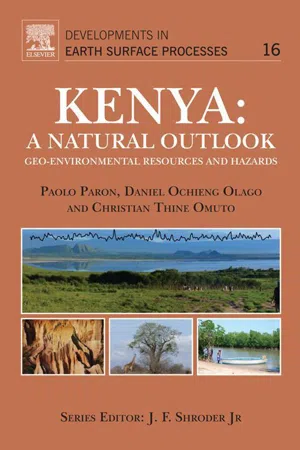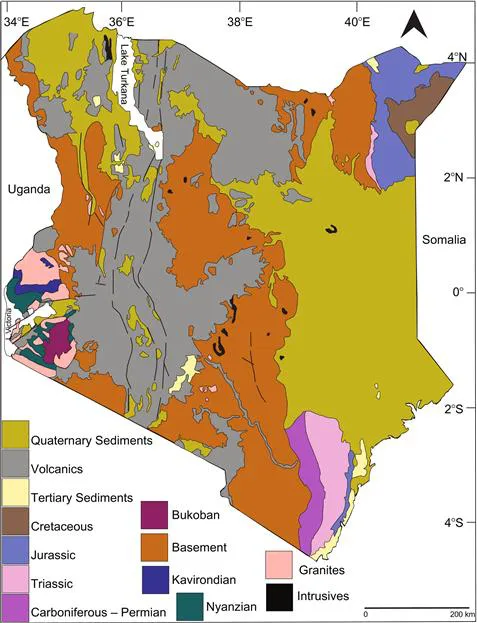![]()
Section I: Natural Resources
Outline
Chapter 1 General Geology of Kenya
Chapter 2 Mineral, Oil and Gas Resources
Chapter 3 Relief, Physiography and Drainage
Chapter 4 Quaternary Evolution
Chapter 5 Climate
Chapter 6 Remote Sensing Application Supporting IWRM in Kenya
Chapter 7 Surface Flows for People and Wildlife in the Transboundary Mara River Basin
Chapter 8 Groundwater Distribution and Aquifer Characteristics in Kenya
Chapter 9 Coastal Waters
Chapter 10 Renewable Energy Resources in Kenya
Chapter 11 Major Soil and Data Types in Kenya
Chapter 12 Vegetation
Chapter 13 Agricultural Expansion and Its Consequences in the Taita Hills, Kenya
Chapter 14 The Importance of Fire Ecology in Protected Areas Management
Chapter 15 Importance and Dynamics of the Mangroves in Kenya
Chapter 16 Freshwater Ecology of Kenyan Highlands and Lowlands
Chapter 17 The Management of Wildlife and Fisheries Resources in Kenya
Chapter 18 Environmental Impact Assessment in Kenya
![]()
Chapter 1
General Geology of Kenya
Norbert Opiyo Akech*, Christine A. Omuombo* and Moses Masibo†, *Department of Geology, College of Biological and Physical Sciences (CBPS), University of Nairobi, PO Box 30197-00100, Nairobi, Kenya, †Commissioner of Mines and Geology, Ministry of Mining, PO Box 30009-00100, Nairobi, Kenya
Abstract
The oldest supracrustal rocks in Kenya are the Archaean Nyanzian meta-volcanics and the Kavirondian meta-sediments. These rocks are found to the west of the country in the areas adjacent to Lake Victoria. The Neo-Proterozoic Mozambique belt rocks occupy the central parts of Kenya. These are in most parts separated from the Archaean rocks by the Tertiary volcanics associated with the East African Rift System. The eastern parts of Kenya from the north to the south are dominated by sedimentary rock sequences ranging in age from the Jurassic to Recent. Large volumes of sediments are also found within the rift floor. Faulting and rifting characterizes the Mesozoic and Quaternary rocks and sediments. Sedimentary deposits of the Permo-Triassic are as a consequence of faulting and subsequent rifting during the break-up of Gondwanaland leading to the distribution of Karoo-like sediments in an intracratonic basin to the east along the Kenyan coast. These sediments are extensively exposed in the south-eastern coastal region and are locally referred to as the Duruma Group, while the small exposures to the northeast are referred to as the Mansa Guda Formation. Notably, Jurassic shales and limestones associated with shallow to deep marine environments are present alongside the Permo-Triassic sediments. The development of the East African Rift System led to the distribution of the Quaternary volcanics and sediments on the floor of the tectonic rift valley trough. Evidence of the Cenozoic history that is characterized by relict erosion surfaces is seen on certain areas of the coastal zone. Quaternary sediments are widely distributed in the country with extensive deposits in the eastern region (east of the Rift Valley) with limited exposures to the northwest.
Keywords
Nyanzian shield; Mozambique Belt; Gondwanaland; Karoo sediments; East African Rift System
1 Introduction
The geology of Kenya can be divided into five major geological successions: (1) the Archaean (Nyanzian and Kavirondian), (2) Proterozoic (Mozambique Belt and Bukoban), (3) Palaeozoic/Mesozoic sediments, (4) Tertiary/Quaternary volcanics and sediments, and (5) Pleistocene to Recent soils, alluvial beach sands, evaporites, fossil coral reefs and sandstones at the coast: alluvial and lacustrine sediments of the Rift Valley. There are also volcanic rocks of the Rift Valley from the younger volcanoes (Figure 1).
Figure 1 Map showing the general geology of Kenya. Simplified from Survey of Kenya (1962).
2 The Nyanzian Shield
The rocks forming the Nyanza Craton (Nyanzian and Kavirondian systems) are Archaean in age and are the oldest rocks in the country. Archaean greenstone belts are on a global scale broadly subdivided into two major groups, the older greenstones with supracrustal rocks that formed between 3.5 and 3.3 Ga and the younger, more widespread greenstone belts formed between 3.0 and 2.5 to 2.2 Ga (Windley, 1984). These greenstones in western Kenya fall in the younger group, with Rb/Sr ages being less than 3.0 Ga (Cahen et al., 1984), and are part of the granite–greenstone belt of the Tanzania Craton. This belt (Figure 1) covers much of northern Tanzania and extends through western Kenya into southeastern Uganda. The Kenyan part of the craton is predominantly composed of a greenstone–trondhjemite–tonalite–granite (TTG) sequence, divided into the Nyanzian and Kavirondian sequences. Within the two sequences are small remnants of the older basement commonly found in the southern half in Tanzania of the craton upon which the TTG sequences were emplaced and are also recognised in the Kenyan sector (Opiyo-Akech, 1988).
The volcanic rocks in the Kenyan sector of the Tanzania Craton constitute a bimodal mafic–felsic suite consistent with sequences found elsewhere in the world (Windley, 1984). The Nyanzian consists mainly of felsic volcanics with lesser amounts of mafic lavas, cherts and banded iron formations. In the southern terrain to the south of the Nyanza Rift, the mafic volcanics are tholeiitic while the felsic volcanics are calc-alkaline and high-K (Ichang'i, 1990; Ichang'i and MacLean, 1991). High-K dacites form a predominant volcanic rock type in the Migori segment of this belt and have a positive chemical correlation with most of the granites. The tholeiitic mafic and calc-alkaline felsic volcanics were erupted into a submarine environment, while the younger high-K dacites were erupted subaerially (Ichang'i, 1990). To the north of the Nyanza Rift in the northern terrain, the volcanic succession is in most parts composed of intermediate to acidic sequences of andesites, dacites and rhyolites of apparent calc-alkaline affinity (Opiyo-Akech, 1988; Ichang’i, 1990), together with related agglomerates and tuffs. There are in some localities relatively large exposures of tholeiitic basalts (lchang'i and MacLean, 1991; Opiyo-Akech, 1992).
The Kavirondian Group rests unconformably on the Nyanzian Group. This group consists of rudites typified by polymictic conglomerates, arenites represented by greywackes and grits, sandstones and argillites characterised by shaly rocks. The rocks have well-developed graded bedding typical of turbidites especially within the arenaceous to argillaceous horizons. Both the Nyanzian and Kavirondian systems are isoclinally folded about axes that have an east-westerly trend.
Intruding through the sequences are plutonic rocks that are typical of what are ordinarily found in other granite–greenstone belts of the world. The granitoids are typical of many ‘TTG’ (trondhjemite–tonalite–granite) plutonic suites that dominate the Archaean but are more potash-rich than most such suites (Ichang’i and MacLean, 1991; Opiyo-Akech et al., 1999a). In the northern terrain belt, the Got Ramogi syenitic intrusion has been encountered (Opiyo-Akech et al., 1999b). Got Ramogi is a relatively small hill with several episodes of syenitic intrusions, the successfully younger phases becoming more silica-deficient. The latest intrusions that occur as pegmatites intruding through older syenites contain large crystals of sodalite as a major mineral phase.
3 The Kisii Group
This is an outlier of volcanic rocks that consists of detrital and shallow-water sediments of the Kisii Group that unconformably overlies the Neo-Archaean greenstones and associated granitoid intrusions. The Kisii Group was initially correlated with rocks of the ‘Bukoban System’ and dated at circa 900 Ma (Huddleston, 1951). From the work by Pinna et al. (2000), it is noted that no comprehensive supracrustal sequence in eastern Africa matches the lithology, petrology and geochronology to the Kisii Group. Single-zircon evaporation Pb/Pb age dating suggests that the Kisii Group has similar ages to the greenstone sequences (2.75–2.58 Ga) in the northern part of the Tanzania Craton, negating the idea that the Kisii Group can be correlated to the Bukoban (Pinna et al., 2000). The volcanics of the Kisii Group are described by Pinna et al. (2000) as being geochemically similar to Phanerozoic continental-arc tholeiitic suites derived from a contaminated mantle. The relationships between these rocks with the underlying Neo-Archaean greenstones have, however, not been fully determined.
4 Mozambique Belt
The Mozambique Belt is a structural unit within which a wide variety of meta-sedimentary and meta-igneous rocks are found showing a broad concordance of structural style and metamorphic history. The most characteristic feature of the Mozambique Belt is its structural trend, which is more or less north–south in its entire belt. In most of these rocks, the degree of deformation is intense and the rocks are of high metamorphic grades. They were thus referred to in the earlier literature as the basement system rocks, due to their high degree of metamorphism and deformation. They have a complex history of superimposed deformation and metamorphism consisting of high-grade reworked or reactivated basement (Muhongo, 1991). It is estimated that the important tectothermal events in this belt took place between 845 and 715 Ma (Cahen et al., 1984; Key et al., 1989). Subsequent reworking of the basement has been traced to ages ranging from 528 to 479 (Shibata and Suwa, 1979; Cahen et al., 1984; Frisch and Pohl, 1986). Recent work on the Mozambique Belt has shown that rocks can be subdivided into groups of contrasting lithology, structure and composition of igneous rocks content. These groups are being studied in greater detail in order to come up with proper chronostratigraphic terminology.
There are basic and ultrabasic intrusions within the Mozambique Belt. These basic to ultrabasic igneous complexes range in size from minor intrusives of bosses and dykes to relatively large bodies. They occur both east and west of the Rift Valley. Some of the older basic intrusions have undergone deformation and metamorphism to give ortho-amphibolites and charnockitic gneisses.
5 Palaeozoic and Mesozoic Sediments
The geological history of the Palaeozoic and Mesozoic sediments in Kenya is linked to the evolution, faulting and subsequent rifting during the break-up of Gondwanaland in the Mesozoic era (Pepper and Everhart, 1963). This break-up was followed by the formation of an intracratonic basin due to downwarping at the end of the Paleozoic, which was later filled by the easterly dipping Permo-Triassic clastic deposits of the Duruma Group, a sandstone series equivalent to the Karoo system of Southern Africa (Caswell, 1953, 1956; Thompson, 1954; Oosterom, 1988). These Permo-Triassic sediments are exposed in northeastern and southeastern regions of Kenya. Extensive exposures are present in the southeastern region where the sediments comprise of the Taru, Maji-ya-Chumvi, Mariakani and Mazeras Formations that consist of grits, shales, sandstones and fluvio-deltaic/Aeolian sequences, respectively (Caswell, 1953, 1956; Ase, 1978, 1981; Cannon et al., 1981; Oosterom, 1988), while in the northeastern region, isolated exposures of t...

